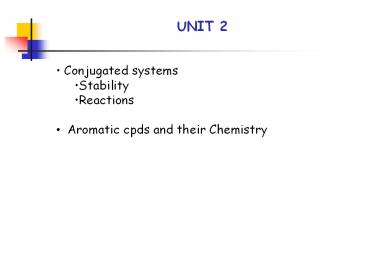Conjugated systems - PowerPoint PPT Presentation
1 / 27
Title:
Conjugated systems
Description:
UNIT 2 Conjugated systems Stability Reactions Aromatic cpds and their Chemistry Simple alkenes The relative stability of an alkene can be determined by comparing the ... – PowerPoint PPT presentation
Number of Views:98
Avg rating:3.0/5.0
Title: Conjugated systems
1
UNIT 2
- Conjugated systems
- Stability
- Reactions
- Aromatic cpds and their Chemistry
2
Simple alkenes
- The relative stability of an alkene can be
determined by comparing the heats of
hydrogenation.
- The more highly substituted alkene is lower in
energy. - The ?H values are additive and can be used to
estimate the heat of reaction for the
hydrogenation of other alkenes. What is the ? H
for the hydrogenation of penta-1,4-diene?
3
Dienes
- There are three types of dienes.
- Isolated dienes (at least one CH2 between the sp2
hybrid carbons) - Conjugated dienes (alternating single and double
bonds) - Cumultive dienes
4
Conjugated alkenes
- The ?H for the hydrogenation of a conjugated
diene is significantly lower than what is
predicted.
The conjugated diene is more stable than the
un-conjugated diene by 17 KJ. This difference in
energy levels (predicted verses found) is called
the resonance energy.
5
Conjugated alkenes
6
MO diagram for Conjugated alkenes
MO diagram for ethylene.
Note that there are only electrons in the bonding
MO.
7
MO diagram for Conjugated alkenes
8
Simple alkenes
- We have seen that reactions occur preferentially
at the allylic position of an alkene.
The reason for the increase in reactivity at the
allylic position is that the reactive
intermediates formed at the allylic position are
resonance stabilized.
Allylic substrates can be used in either Sn1 or
Sn2 reactions. Note that whenever there is a
reactive intermediate that is resonance
stabilized there is the possibility of two or
more products.
9
Resonance stabilization of reactive intermediates
Draw the other resonance structures for the last
three cations. Draw the resonance structures of
the corresponding free radicals and anions.
10
Allylic halides are also excellent substrates for
SN2 reactions (involve strong nucleophiles) due
to overlap of the temporary p orbital in the
transition state with adjacent p orbitals of the
double bond.
11
Reactions of alkenes
Alkenes can under go either addition reactions or
substitution reactions in the allylic position.
What products would be formed from the addition
of HBr? The addition of Br2/H2O? What is NBS?
What about Sn1 and Sn2 reactions?
12
Reactions of alkenes
With conjugated alkenes the reactive site may be
delocalized over two or more atoms in the
molecule.
13
Reactions of conjugated alkenes
When adding one equivalent of reagent you will
obtain two addition products.
What would happen with a excess of reagent?
14
Reactions of conjugated alkenes
To understand the above observation we must
consider both the kinetics and the thermodynamics
of the reaction.
15
Reactions of conjugated alkenes
What happens to the kinetics of the two reactions
at low temperature? Why is the lowest energy
product formed at higher temperature?
16
Diels-Alder Reaction
The Diels-Alder reaction is a concerted
cycloaddition reaction. Also called a 42
cycloaddition. The reagents are an electron rich
diene and an electron deficient alkene
(dienophile).
17
Diels-Alder Reaction
The dienophile can also be an electron deficient
alkyne.
18
Diels-Alder Reaction
Two possible planar conformations for conjugated
dienes
s-cis
s-trans
The rotational barrier around the C2-C3 bond is
about 5 kcal/mol. At room temperature there is
essentially free rotation about this bond. The
s-cis conformation is a stereo chemical
requirement for the Diels-Alder reactions.
19
Diels-Alder Reaction
Things to consideration when drawing the product
of a Diels-Alder reaction. 1. Stereochemistry of
the diene. 2. Stereochemistry of the
product. 3. Orientation of the diene to the
dienophile (where are the substituents
going to be on the ring).
20
Diels-Alder Reaction
Things to consideration when drawing the product
of a Diels-Alder reaction. 1. Stereochemistry of
the diene. 2. Stereochemistry of the
product. 3. Orientation of the diene to the
dienophile (where are the substituents
going to be on the ring).
21
Diels-Alder Reaction
When there is a pi bond in the electron
withdrawing group of the dienophile the group is
generally going to be in the endo position in the
product. This is called the endo rule. We will
always use the above orientation of the diene and
dienophile when predicting the product of a
Diels-Alder reaction.
22
Diels-Alder Reaction
With the dienophile coming from the bottom the
following the stereochemistries will be observed.
The substituent groups pointing inside the
diene get pushed up, groups pointing outside
the diene get pushed down, and electron
withdrawing groups end up in down positions
whenever possible.
23
Diels-Alder Reaction
24
Diels-Alder Reaction
25
Diels-Alder Reaction
Predict products for the following reactions
26
Diels-Alder Reaction
Predict products for the following reactions
27
Diels-Alder Reaction
Draw the structures of the dienes and dienophiles
used to make the following Diels-Alder adducts

